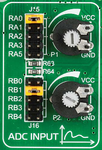PLEG54
Newbie level 4
Hi omega6,
I have testing your code on EasyPIC7, but this will not work properly...
I placed an oscilloscope on GP0 and GP2 and GP2 sgnal goes from 0 to high (4.84V) with an input voltage (GP0) higher than 1,45V. Room temperature (measured with a digital thermometer IR) of LM35 was 22.5 ° C, which is equivalent to an output voltage of 200mV sensor, with a voltage VDD measured 4,90V.
How is this possible ?
I'm interested in the problems of this assembly, for my own learning.
Many thanks for your answer...
Best regards,
Philippe
I have testing your code on EasyPIC7, but this will not work properly...
I placed an oscilloscope on GP0 and GP2 and GP2 sgnal goes from 0 to high (4.84V) with an input voltage (GP0) higher than 1,45V. Room temperature (measured with a digital thermometer IR) of LM35 was 22.5 ° C, which is equivalent to an output voltage of 200mV sensor, with a voltage VDD measured 4,90V.
How is this possible ?
I'm interested in the problems of this assembly, for my own learning.
Many thanks for your answer...
Best regards,
Philippe


![EasyPIC7_Schema ADC inputs_[640x260px].png EasyPIC7_Schema ADC inputs_[640x260px].png](https://www.edaboard.com/data/attachments/57/57100-d957cf9f426716af207b73db98f8b8ad.jpg)
![EasyPIC7_Schema Power_[640x286px].png EasyPIC7_Schema Power_[640x286px].png](https://www.edaboard.com/data/attachments/57/57101-2d4636b503e5484c70b3c81d17f9bd09.jpg)
![Step ADC_[640x360px].png Step ADC_[640x360px].png](https://www.edaboard.com/data/attachments/57/57105-c70b72e52d48789dde29e99a90ba299d.jpg)
![DAC VCF_[398x640px].png DAC VCF_[398x640px].png](https://www.edaboard.com/data/attachments/57/57115-93ddeb3948bae6166c0d116ee25d6bea.jpg)
![Fluke77 mesure_[360x640px].png Fluke77 mesure_[360x640px].png](https://www.edaboard.com/data/attachments/57/57116-14542d58bd67dfecaca5fe668826de39.jpg)